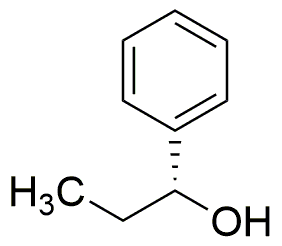(R)-(+)-1-Phenyl-1-propanol is widely utilized in research focused on:
- Pharmaceutical Development: This compound serves as an important intermediate in the synthesis of various pharmaceuticals, particularly in the production of chiral drugs, which are essential for enhancing therapeutic efficacy.
- Flavor and Fragrance Industry: It is used as a flavoring agent and fragrance component due to its pleasant aroma, making it valuable in the formulation of perfumes and food products.
- Chiral Auxiliary in Organic Synthesis: The compound acts as a chiral auxiliary, facilitating asymmetric synthesis processes in organic chemistry, which is crucial for creating compounds with specific stereochemistry.
- Research in Material Science: It is explored in the development of new materials, particularly in the creation of polymers and resins that require specific optical properties.
- Analytical Chemistry: This compound is utilized as a standard reference material in analytical techniques such as chromatography, aiding in the accurate quantification of similar compounds in complex mixtures.
General Information
Properties
Safety and Regulations
Applications
(R)-(+)-1-Phenyl-1-propanol is widely utilized in research focused on:
- Pharmaceutical Development: This compound serves as an important intermediate in the synthesis of various pharmaceuticals, particularly in the production of chiral drugs, which are essential for enhancing therapeutic efficacy.
- Flavor and Fragrance Industry: It is used as a flavoring agent and fragrance component due to its pleasant aroma, making it valuable in the formulation of perfumes and food products.
- Chiral Auxiliary in Organic Synthesis: The compound acts as a chiral auxiliary, facilitating asymmetric synthesis processes in organic chemistry, which is crucial for creating compounds with specific stereochemistry.
- Research in Material Science: It is explored in the development of new materials, particularly in the creation of polymers and resins that require specific optical properties.
- Analytical Chemistry: This compound is utilized as a standard reference material in analytical techniques such as chromatography, aiding in the accurate quantification of similar compounds in complex mixtures.
Documents
Safety Data Sheets (SDS)
The SDS provides comprehensive safety information on handling, storage, and disposal of the product.
Product Specification (PS)
The PS provides a comprehensive breakdown of the product’s properties, including chemical composition, physical state, purity, and storage requirements. It also details acceptable quality ranges and the product's intended applications.
Certificates of Analysis (COA)
Search for Certificates of Analysis (COA) by entering the products Lot Number. Lot and Batch Numbers can be found on a product’s label following the words ‘Lot’ or ‘Batch’.
*Catalog Number
*Lot Number
Certificates Of Origin (COO)
This COO confirms the country where the product was manufactured, and also details the materials and components used in it and whether it is derived from natural, synthetic, or other specific sources. This certificate may be required for customs, trade, and regulatory compliance.
*Catalog Number
*Lot Number
Safety Data Sheets (SDS)
The SDS provides comprehensive safety information on handling, storage, and disposal of the product.
DownloadProduct Specification (PS)
The PS provides a comprehensive breakdown of the product’s properties, including chemical composition, physical state, purity, and storage requirements. It also details acceptable quality ranges and the product's intended applications.
DownloadCertificates of Analysis (COA)
Search for Certificates of Analysis (COA) by entering the products Lot Number. Lot and Batch Numbers can be found on a product’s label following the words ‘Lot’ or ‘Batch’.
*Catalog Number
*Lot Number
Certificates Of Origin (COO)
This COO confirms the country where the product was manufactured, and also details the materials and components used in it and whether it is derived from natural, synthetic, or other specific sources. This certificate may be required for customs, trade, and regulatory compliance.


